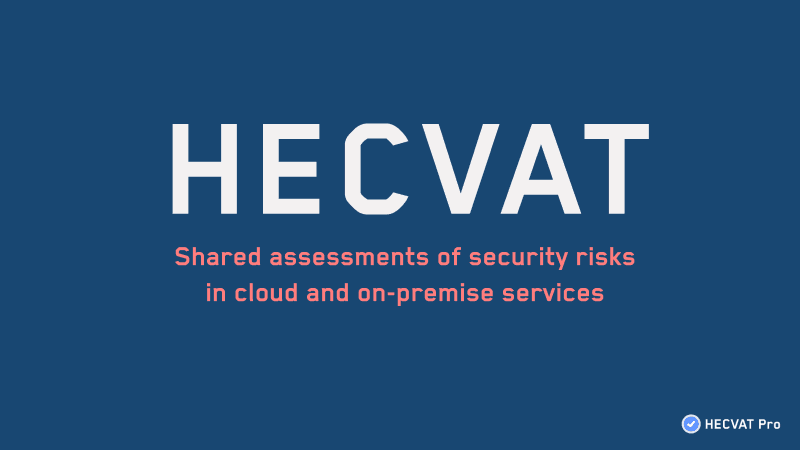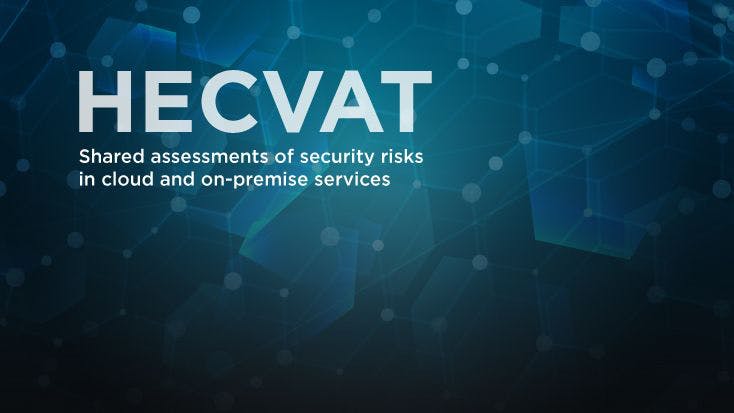Table of Contents
ToggleEmpowering Education: Ultimate Cybersecurity Assessment Guide
Cybersecurity is a pivotal concern for educational institutions. Recognizing vulnerabilities and implementing robust cybersecurity measures is essential for safeguarding sensitive information and ensuring a secure learning environment. This comprehensive guide, propelled by insights from HECVATPro, delineates the paramount aspects of cybersecurity assessment in the educational sector. Our aim is not just to inform but to equip educators and IT professionals with the tools they need for a fortified cybersecurity front.
Table of Contents
- Introduction to Cybersecurity in Education
- The Necessity of Cybersecurity Assessments
- Key Components of a Cybersecurity Assessment
- Vulnerability Analysis
- Risk Assessment
- Compliance with Regulatory Standards
- Implementing Cybersecurity Measures
- Preventive Measures
- Detective Measures
- Responsive Measures
- HECVAT: Streamlining Cybersecurity Assessments
- Conclusion
- Accessibility Commitment
Introduction to Cybersecurity in Education
The education sector is increasingly becoming a target for cyber-attacks due to the vast amounts of personal and institutional data it harbors. From students’ personal information to academic research, the potential for data breaches makes cybersecurity paramount.
Table 1: Common Cyber Threats in Education
| Threat Type | Description |
|---|---|
| Phishing | Attempts to steal sensitive information via fraudulent communication. |
| Ransomware | Malicious software that locks access to data or systems unless a ransom is paid. |
| DDoS Attacks | Overwhelming a system’s resources to disrupt service. |
| Insider Threats | Security threats posed by individuals within the organization. |
The Necessity of Cybersecurity Assessments
Cybersecurity assessments provide educators and IT professionals with a comprehensive overview of their institution’s cybersecurity posture. It’s a proactive approach to identify vulnerabilities, assess risks, and ensure compliance with legal and regulatory standards.
Figure 1: Cybersecurity Assessment Process Flow
[Identification of Assets] ---> [Vulnerability Analysis] ---> [Risk Assessment]
---> [Mitigation Strategies] ---> [Implementation] ---> [Monitoring]
Key Components of a Cybersecurity Assessment
Vulnerability Analysis
This initiates with mapping out all digital assets and evaluating them for known vulnerabilities, which could potentially be exploited by attackers.
Risk Assessment
Risk assessment involves analyzing the identified vulnerabilities to determine the potential impacts on the institution and prioritizing them based on severity.
Compliance with Regulatory Standards
Ensuring that cybersecurity practices align with legal and regulatory requirements is crucial for educational institutions to avoid penalties and safeguard their reputation.
Implementing Cybersecurity Measures
With a clear understanding of vulnerabilities and risks, institutions can implement tailored cybersecurity measures.
Table 2: Cybersecurity Measures
| Category | Measures |
|---|---|
| Preventive | Firewalls, Antivirus software, Strong password policies |
| Detective | Intrusion detection systems, Security software updates, Regular auditing |
| Responsive | Incident response plan, Data backup and recovery strategies |
HECVAT: Streamlining Cybersecurity Assessments
HECVATPro is specifically designed to address and streamline cybersecurity assessments in the education sector. By offering a comprehensive assessment toolkit, HECVATPro simplifies the complex process of ensuring cybersecurity resilience.
Why Choose HECVAT?
- Tailored for Education: Specifically designed with educational institutions in mind.
- Comprehensive Assessment: Covers all critical aspects of cybersecurity, ensuring a thorough evaluation.
For more information on how HECVATPro can bolster your institution’s cybersecurity posture, visit our HECVATPro Information and immerse in the dedicated resources available.
Conclusion
Cybersecurity in education is not merely a requirement but a necessity in the digital age. Through meticulous assessment and the implementation of strategic measures, institutions can safeguard against the incessant threats that loom in the cyber domain. Embracing solutions like HECVATPro empowers educational entities to navigate the complexities of cybersecurity with confidence and ensure a safer future for all stakeholders involved.
Accessibility Commitment
At HECVATPro, we unequivocally commit to ensuring our digital solutions are accessible to all. We ardently believe in fostering an inclusive environment, transcending barriers, and enabling seamless access to our cybersecurity resources. For details on our accessibility efforts, visit our Accessibility Statement.
With a steadfast approach to cybersecurity assessment and adherence to best practices, educational institutions can not only protect their digital frontiers but can also shape a secure future for the learning community. Equip your institution with the knowledge and tools it needs to thwart cyber threats – because in the realm of digital security, awareness, and preparedness are your best defense.
Continuing from where we left off, bolstering cybersecurity in educational institutions doesn’t just stop at assessments and implementing protective measures. It extends into creating a culture of cybersecurity awareness and constant evolution to counter new and emerging threats. Let’s delve deeper into fostering a cybersecurity culture and the evolving landscape of cybersecurity threats.
Fostering a Cybersecurity Culture in Education
Awareness and Training
The human element often proves to be the weakest link in cybersecurity. Regular training sessions for staff and students can significantly mitigate this risk. Topics should cover recognizing phishing attempts, importance of regular password changes, and safe browsing practices.
Table 3: Cybersecurity Training Topics
| Audience | Topics |
|---|---|
| Staff | Data protection, Recognizing phishing, Safe online practices |
| Students | Secure browsing, Social media risks, Personal data safeguarding |
Regular Updates and Patches
Cyber threats evolve rapidly; therefore, keeping software and systems updated is critical. Regularly scheduled updates should be institutionalized to patch vulnerabilities swiftly.
Incident Response and Recovery
An effective incident response plan ensures that the institution can quickly react to breaches, minimize damages, and restore services. This plan should be regularly reviewed and updated to adapt to new threats.
Figure 2: Incident Response Cycle
[Preparation] ---> [Detection and Analysis] ---> [Containment, Eradication, and Recovery] ---> [Post-Incident Activity]
Evolving Landscape of Cybersecurity Threats
The cybersecurity landscape is in a constant state of flux, with new threats emerging as technology advances. Let’s explore some upcoming threats and how education institutions can prepare for them.
AI-Powered Attacks
Artificial Intelligence (AI) technology isn’t just a tool for defenders; it’s also being utilized by attackers to craft more sophisticated phishing attempts and automate attacks at an unprecedented scale.
Mitigation Strategy
Educational institutions should invest in AI-driven security solutions for proactive threat detection and response, staying a step ahead of AI-powered attacks.
IoT Vulnerabilities
The Internet of Things (IoT) devices are becoming commonplace in educational settings, from smart boards to temperature sensors. These devices often lack robust security, presenting a new array of vulnerabilities.
Mitigation Strategy
Implement strict security protocols for IoT devices, including regular security assessments and segregation of IoT devices from critical networks.
Ransomware 2.0
Ransomware attacks are becoming more targeted and sophisticated, with attackers spending significant time within networks to maximize impact. The rise of “Ransomware-as-a-Service” platforms further complicates this threat.
Mitigation Strategy
Beyond preventive measures like backups and anti-malware, institutions should focus on early detection through behavior analysis and having a solid ransomware response strategy in place.
Looking to the Future: Cybersecurity in Education
The journey towards a secure educational environment is ongoing and requires vigilance, foresight, and adaptability. As we’ve discussed, from fostering a robust cybersecurity culture to preparing for the evolving threats, it’s clear that cybersecurity is a critical pillar in safeguarding our educational institutions.
In embracing the comprehensive resources offered by HECVATPro, institutions are not only securing their immediate digital environs but are also laying down the groundwork for a resilient, responsive, and secure educational future. For more insights and support on navigating these cybersecurity challenges, HECVATPro’s dedicated resources are an invaluable asset.
As we navigate the complexities of the digital age, let us remember: our strength lies in our readiness and our collaborative efforts to protect the sanctity of educational environments. Together, we can forge a path towards a secure and inclusive digital future for all.
In conclusion, cybersecurity in the educational sector is not static; it’s a dynamic battleground that requires continuous engagement, refinement of strategies, and most importantly, collective action. By staying informed, vigilant, and proactive, educational institutions can not only face the cybersecurity challenges of today but also anticipate and prepare for the threats of tomorrow.
Stay Safe, Stay Informed, Stay Ahead.
For further resources and guidance on making your educational institution a fortress against cyber threats, visit our website at HECVATPro. Together, let’s ensure a safe, secure, and inclusive digital education landscape.



